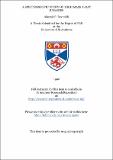Files in this item
A spectroscopic study of high mass X-ray binaries
Item metadata
| dc.contributor.advisor | Hilditch, R. W. | |
| dc.contributor.author | Reynolds, Alastair P. | |
| dc.coverage.spatial | 166 p. | en_US |
| dc.date.accessioned | 2018-06-25T08:49:28Z | |
| dc.date.available | 2018-06-25T08:49:28Z | |
| dc.date.issued | 1992 | |
| dc.identifier.uri | https://hdl.handle.net/10023/14509 | |
| dc.description.abstract | Observations of four massive x-ray binary stars are presented, based on data accumulated between February 1989 and August 1991. Using modern techniques of spectroscopic data analysis, velocity curves are derived for three of these systems. Two of these curves (SMC X-1, QV Nor) yield very precise mass estimates for the component stars, while the third (Cen X-3) offers a constraint on the possible masses. The fourth system (X Per) is not shown to exhibit periodic variations, despite an extensive study conducted over more than two years. For the two systems that yielded precise masses, the component neutron stars are shown to lie within the theoretical mass range based on theories of their formation via the supernova explosion of a helium star in a close binary system. This is a marked improvement on previous studies where both stars had estimated masses which lay well outside of the expected range. The derivation of these masses incorporates the use of non-Keplerian velocity corrections, arising from the non-spherical, asymmetrically illuminated primary stars. A study of the line profiles showed that the temperatures around both primary stars were consistent with the parameters in these calculations. For the third system, the inaccuracy of the published ephemeris resulted in a lack of observations at the times of maximum and minimum velocity. The semi-amplitude is thus not well constrained, but it is shown that the observations are consistent with the assumption of a normal mass neutron star secondary. The system is shown to have undergone a gradual decrease in its orbital period which follows a parabolic trend, suggesting substantial mass-transfer. For the fourth system, a periodicity analysis of 130 spectroscopic velocity measurements of a Be star, via Fouriergram and string-length techniques, failed to highlight any strong periodicity. The scatter in the data appears larger than would be expected for a non-variable B star. The absence of periodic velocity variations at the expected period is discussed in terms of the binarity (or otherwise) of the Be star. A transition from Be to shell-star or ordinary B star phase occurred during the study, which is not evident from the spectral variations observed in the blue. | en_US |
| dc.language.iso | en | en_US |
| dc.publisher | University of St Andrews | |
| dc.subject.lcc | QB903.R3 | |
| dc.subject.lcsh | Double stars | en |
| dc.title | A spectroscopic study of high mass X-ray binaries | en_US |
| dc.type | Thesis | en_US |
| dc.contributor.sponsor | Science and Engineering Research Council (SERC) | en_US |
| dc.type.qualificationlevel | Doctoral | en_US |
| dc.type.qualificationname | PhD Doctor of Philosophy | en_US |
| dc.publisher.institution | The University of St Andrews | en_US |
This item appears in the following Collection(s)
Items in the St Andrews Research Repository are protected by copyright, with all rights reserved, unless otherwise indicated.

